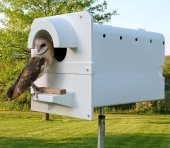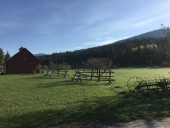
 7
7




Visit Redhawk's soil series: https://permies.com/wiki/redhawk-soil
How permies.com works: https://permies.com/wiki/34193/permies-works-links-threads
 4
4









Invasive plants are Earth's way of insisting we notice her medicines. Stephen Herrod Buhner
Everyone learns what works by learning what doesn't work. Stephen Herrod Buhner
 5
5




Absolutely! More than that, you want to consider which raptors you want to encourage. We have Barred Owls in our area, but they tend to harass other raptors, so I wouldn't build nest boxes for them. We also have Great Horned Owls, and I would try to support their re-population efforts, as well as Screech Owls, as they're struggling.I may be wrong though I feel that nest boxes would be best built for the raptors that frequent a person's area.
Visit Redhawk's soil series: https://permies.com/wiki/redhawk-soil
How permies.com works: https://permies.com/wiki/34193/permies-works-links-threads
 8
8




Anne Miller wrote:
I am not sure what kinds of birds would like this nest though it looks easy:

source
 3
3




There are 26 bird species in the world named buzzard, including the European honey-buzzard, lizard buzzard, forest buzzard, and long-legged buzzard. At least one buzzard species can be found on every continent except Antarctica.
Buzzards are a type of hawk, specifically, buteos, and they are in the family Accipitridae. These are medium- to large-sized hawks with broad wings ideal for soaring on thermal currents.
Invasive plants are Earth's way of insisting we notice her medicines. Stephen Herrod Buhner
Everyone learns what works by learning what doesn't work. Stephen Herrod Buhner
 3
3




Anne Miller wrote:The only raptors we have where we live now are buzzards (or vultures). I am not sure which though I call them buzzards.
Since we have so many the other raptors might be less likely to frequent my area.
We need the buzzards because this is a hunter's paradise country and there are many hunter's dump sites.
For those that might be interested in raptors, especially buzzards, they are a hawk:
There are 26 bird species in the world named buzzard, including the European honey-buzzard, lizard buzzard, forest buzzard, and long-legged buzzard. At least one buzzard species can be found on every continent except Antarctica.
Buzzards are a type of hawk, specifically, buteos, and they are in the family Accipitridae. These are medium- to large-sized hawks with broad wings ideal for soaring on thermal currents.
https://www.thespruce.com/buzzards-vs-vultures-4171318
There are plenty of trees for the buzzards to roost in though I have no idea where their nests are.
For those who want to build a nest box, there is a PEP Badge Bit for that:
https://permies.com/wiki/107920/pep-animal-care/Build-nice-birdhouse-specific-species#1186053
 2
2




Jay Angler wrote:Just this week, the dailyish posted this thread: https://permies.com/t/207474/wildlife/attract-birds-prey-backyards
Most people think about providing food, but a quick search supported my big concern, which is that many birds of prey lack suitable nesting spots to be successful in city, urban, and manicured rural areas.
Luckily, my area has a fair bit of standing dead wood, and a few years ago, we had a pair of Great Horned Owls fledge a pair of youngsters and watching them grow up was a pleasure and a privilege.
 3
3




Invasive plants are Earth's way of insisting we notice her medicines. Stephen Herrod Buhner
Everyone learns what works by learning what doesn't work. Stephen Herrod Buhner
 4
4





|
The only thing that kept the leeches off of me was this tiny ad:
Learn Permaculture through a little hard work
https://wheaton-labs.com/bootcamp
|






